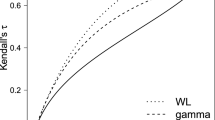Summary
We introduce a shared random-effect model, derived from frailty models to account for informative dropout. We extend the iterative weighted least squares algorithm for hierarchical generalized linear models to shared random-effect models. Monte-Carlo simulations are carried out to illustrate that the proposed method works well whether the random-effect distribution is correctly specified or not.
Similar content being viewed by others
References
Breslow, N.E. & Clayton, D.G. (1993), ‘Approximate inference in generalized linear mixed models’,Journal of the American Statistical Association 88, 9–25.
Breslow, N.E. & Lin, X. (1995), ‘Bias correction in generalized linear mixed models with a single component of dispersion’,Biometrika 82, 81–91.
Cox, D.R. (1972), ‘Regression models & life-tables (with discussion)’,Journal of the Royal Statistical Society B 34, 187–220.
Follmann, D.A. & Wu, M.C. (1995), ‘An approximate generalized linear model with random effects for informative missing data’,Biometrics 51, 151–168.
Gueorguieva, R.V. (2001), ‘A multivariate generalized linear mixed model for joint modelling of clustered outcomes in the exponential family’,Statistical Modelling 1, 177–193.
Ha, I.D. & Lee, Y. (2003), ‘Estimating frailty models via Poisson hierarchical generalized linear models’,Journal of Computational and Graphical Statistics 12, 663–681.
Ha, I.D., Lee, Y. & Song, J.K. (2002), ‘Hierarchical likelihood approach for mixed linear models with censored data’,Lifetime Data Analysis 8, 163–176.
Hinde, J. (1982),Compound Poisson regression models, In R Gilchrist (Ed.), GLIM 82 New York, 109–121: Springer-Verlag.
Kalbfleisch, J.D. & Prentice, R.L. (1973), ‘Marginal likelihoods based on Cox’s regression and life model’,Biometrika 60, 267–278.
Lee, Y. & Nelder, J.A. (1996), ‘Hierarchical generalized linear models with discussion)’,Journal of the Royal Statistical Society B 58, 619–678.
Lee, Y. & Nelder, J.A. (2001), ‘Hierarchical generalized linear models: A synthesis of generalized linear models, random-effect model and structured dispersion’,Biometrika 88, 987–1006.
Lee, Y. & Nelder, J.A. (2003), ‘Extended REML estimators’,Journal of Applied Statistics 30, 845–856.
Lee, Y. & Nelder, J.A. (2004), ‘Conditional and marginal models: another view (with discussion)’, to appear in Statistical Science.
Liu, Q. & Pierce, D.A. (1993), ‘Heterogeneity in Mantel-Haenszel-type models’,Biometrika 80, 543–546.
McCullagh, P. & Nelder, J.A. (1989),Generalized Linear Models 2nd edn, London: Chapman and Hall.
McCulloch, C.E. (1997), ‘Maximum likelihood algorithms for generalized linear mixed models’,Journal of the American Statistical Association 92, 162–170.
Noh, M. & Lee, Y. (2004), ‘Review of estimating methods for binary data in generalised linear mixed models’, manuscript submitted for publication.
Pulkstenis, E.P., Ten Have, T. R. & Landis, J. R. (1998), ‘Model for the Analysis of Binary Longitudinal Pain Data Subject to Informative Dropout Through Remedication’,Journal of the American Statistical Association 93, 438–450.
Ten Have, T. R., Kunselman, A.R., Pulkstenis, E. P. &, Landis, J.R. (1998), ‘Mixed effects logistic regression models for longitudinal binary response data with informative dropout’,Biometrics 54, 367–383.
Verbeke, G. & Lesaffre, E. (1997), ‘The effect of misspecifying the randomeffects distribution in linear mixed models for longitudinal data’,Computational Statistics and Data Analysis 23, 541–556.
Wu, M.C. & Bailey, K.R. (1989), ‘Estimation and comparison of changes in the presence of informative right censoring: conditional linear model’,Biometrics 45, 939–955.
Wu, M.C. & Carroll, R.J. (1988), ‘Estimation and comparison of changes in the presence of informative right censoring by modeling the censoring process’,Biometrics 44, 175–188.
Yun, S. & Lee, Y. (2004), ‘Comparison of Hierarchical and Marginal Likelihood Estimators for Binary Outcomes’,Computational Statistics and Data Analysis 45, 639–650.
Acknowledgments
The authors thank Professor Roger Payne and Professor Thomas Ten Have for their helpful comments.
Author information
Authors and Affiliations
Additional information
This study was supported by a grant of the Korea Health 21 R & D Project, Ministry of Health & Welfare, Republic of Korea. (01-PJ1-PG3-51200-0002).
Rights and permissions
About this article
Cite this article
Lee, Y., Noh, M. & Ryu, K. HGLM modelling of dropout process using a frailty model. Computational Statistics 20, 295–309 (2005). https://doi.org/10.1007/BF02789705
Published:
Issue Date:
DOI: https://doi.org/10.1007/BF02789705




